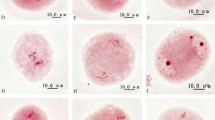Abstract
Artificially inducing 2n gametes through chromosome doubling is an effective way to obtain polyploids. In this study, Eucalyptus urophylla microsporogenesis and flower development were investigated to guide 2n pollen induction. We also investigated suitable conditions for colchicine treatment. Our results showed that E. urophylla 2n pollen was spherical and had a large volume (mean diameter 28.57 ± 0.46 μm), while normal untreated pollen (mean diameter 19.68 ± 0.11 μm) was tetrahedron. The highest rate of 2n pollen production was 28.71 % when the flower buds, which ranged in size from 3.5 to 4.0 mm, underwent treatment with 0.5 % colchicine solution for 6 h. Further studies suggested that diplotene to diakinesis and metaphase I to telophase I were suitable meiotic stages for chromosomes doubling, due to asynchronous development of microsporogenesis between the anthers in a single flower bud. These data help to illuminate research in other areas, such as triploid eucalyptus production by chromosome doubling of female gametes.



Similar content being viewed by others
References
Adiwilaga KD, Brown CR (1991) Use of 2n pollen-producing triploid hybrids to introduce tetraploid Mexican wild species germ plasm to cultivated tetraploid potato gene pool. Theor Appl Genet 81:645–652
Akutsu M, Kitamura S, Toda R, Miyajima I, Okazaki K (2007) Production of 2n pollen of Asiatic hybrid lilies by nitrous oxide treatment. Euphytica 155:143–152
Arisumi T (1964) Colchicine-induced tetraploid and cytochimeral daylilies. J Hered 55:255–260
Barba-Gonzalez R, Miller CT, Ramanna MS, van Tuyl JM (2006) Nitrous oxide (N2O) induces 2n gametes in sterile F1 hybrids between oriental × asiatic lily (Lilium) hybrids and leads to intergenomic recombination. Euphytica 148:303–309
Becerra LL, Orjeda G (2002) Occurrence and cytological mechanism of 2n pollen formation in a tetraploid accession of Ipomoea batatas (sweet potato). J Hered 93:185–192
Blackmore S, Wortley AH, Skvarla JJ, Rowley JR (2007) Pollen wall development in flowering plants. New Phytol 174:483–498
Brooker MIH (2000) A new classification of the genus Eucalyptus L’Hér. (Myrtaceae). Aust Syst Bot 13:79–148
Crespel L, Ricci SC, Gudin S (2006) The production of 2n pollen in rose. Euphytica 151:155–164
Davis GL (1968) Floral morphology and the development of gametophytes in Eucalyptus melliodora A. Cunn. Aust J Bot 16:19–35
Davis GL (1969) Floral morphology and the development of the gametophytes in Eucalyptus stellulata Sieb. Aust J Bot 17:177–190
Dewitte A, Eeckhaut T, van Huylenbroeck J, van Bockstaele E (2009) Meiotic aberrations during 2n pollen formation in Begonia. Heredity 104:215–223
Dewitte A, Eeckhaut T, van Huylenbroeck J, van Bockstaele E (2010) Induction of 2n pollen formation in Begonia by trifluralin and N2O treatments. Euphytica 171:283–293
Doughty RW (2000) The Eucalyptus. A natural and commercial history of the gum tree. The Johns Hopkins Univ Press, Baltimore, p 237
Dover GA (1972) The organization and polarity of pollen mother cells of Triticum aestivum. J Cell Sci 11:699–711
Einspahr DW (1984) Production and utilization of triploid hybrid aspen. Iowa State J Res 58:401–409
Eldridge K, Davidson J, Harwood C, van Wyk G (1993) Eucalypt domestication and breeding. Oxford University Press, Oxford, p 288
Gao P, Lin W, Kang X (2004) Pollen chromosome doubling of Eucommia ulmoides induced by colchicine. J Beijing For Univ 26:39–42
Hahn SK, Bai KV, Asiedu R (1990) Tetraploids, triploids, and 2n pollen from diploid interspecific crosses with cassava. Theor Appl Genet 79:433–439
Han C, Xu JM, Du ZH, Li GY, Zeng BS, Wu SJ, Wang W (2011) Polyploidy induction of clone of Eucalyptus grandis with colchicine. Afr J Biotechnol 10:14711–14717
Janaki-Ammal EK, Khosla SN (1969) Breaking the barrier to polyploidy in the genus Eucalyptus. Proc Indian Acad Sci Sect B 70:248–249
Johnsson H, Eklundh C (1940) Colchicine treatment as a method in breeding hardwood species. Sven Papp Tidn 43:373–377
Kang X, Zhu Z, Lin H (1999) Study on the effective treating period for pollen chromosome doubling of Populus tomentosa × P. Bolleana. Sci Silave Sin 35:21–24
Kang X, Zhu Z, Zhang Z (2000) Suitable period of high temperature treatment for 2n pollen of Populus tomentosa × P. bolleana. J Beijing For Univ 22:1–4
Kang X, Zhang P, Gao P, Zhao F (2004) Discovery of a new way of poplar triploids induced with colchicine after pollination. J Beijing For Univ 26:1–4
Kobayashi N, Yamashita S, Ohta K, Hosoki T (2008) Morphological characteristics and their inheritance in colchicines-induced Salvia polyploids. J Jpn Soc Hortic Sci 77:186–191
Ladiges PY, Udovicic F, Nelson G (2003) Australian biogeographical connections and the phylogeny of large genera in the plant family Myrtaceae. J Biogeogr 30:989–998
Li YH, Kang XY, Wang SD, Zhang ZH, Chen HW (2008) Triploid induction in Populus alba × P. glandulosa by chromosome doubling of female gametes. Silvae Genet 57:37–40
Li Y, Guo Q, Wang J, Tian J, Kang X (2014) Colchicine-induced pollen chromosome doubling and its cytological effects in Populus alba L. J Nucl Agric Sci 28:749–756
Lin H, Jian M, Liang LY, Pei WJ, Liu XZ, Zhang HY (2010) Production of polyploids from cultured shoot tips of Eucalyptus globulus Labill by treatment with colchicine. Afr J Biotechnol 9:2252–2255
Lu M, Zhang P, Kang X (2013) Induction of 2n female gametes in Populus adenopoda Maxim by high temperature exposure during female gametophyte development. Breed Sci 63:96–103
Lu M, Zhang P, Wang J, Kang X, Wu J, Wang X, Chen Y (2014) Induction of tetraploidy using high temperature exposure during the first zygote division in Populus adenopoda Maxim. Plant Growth Regul 72:279–287
Mao YK, Zhang PD, Shi L, Dong CB, Suo YJ, Kang XY (2013) The optimum conditions for inducing 2n pollen chromosome doubling by high temperature in Eucommia Ulmoides. J Beijing For Univ 35:53–58
Myburg AA, Potts BM, Marques CM, Kirst M, Gion GM, Grattapaglia D, Grima-Pettenatti J (2007) Eucalyptus. In: Kole C (ed) Genome mapping and molecular breeding in plants, volume 7, forest trees. Springer, Berlin, pp 115–160
Okazaki K, Kurimoto K, Miyajima I, Enami A, Mizuochi H, Matsumoto Y, Ohya H (2005) Induction of 2n pollen in tulips by arresting the meiotic process with nitrous oxide gas. Euphytica 143:101–114
Pereira RC, Ferreira MTM, Davide LC, Pasqual M, Mittelmann A, Techio VH (2014) Chromosome duplication in Lolium multiflorum Lam. Crop Breed Appl Biotechnol 14:251–255
Potts BM, Dungey HS (2004) Interspecific hybridization of Eucalyptus: key issues for breeders and geneticists. New Forest 27:115–138
Potts BM, Jackson WD (1986) Evolutionary processes in the Tasmanian high altitude eucalypts. In: Barlow BA (ed) Flora and fauna of alpine Australasia. Ages and origins. CSIRO, Melbourne, pp 511–527
Potts BM, Reid JB (1988) Hybridisation as dispersal mechanism. Evolution 42:1245–1255
Takamura T, Miyajima I (1996) Colchicine induced tetraploids in yellow-flowered cyclamens and their characteristics. Sci Hortic 65:305–312
van Tuyl JM, Meijer B, van Diën MP (1992) The use of oryzalin as an alternative for colchicine in in vitro chromosome doubling of Lilium and Nerin e. Acta Hortic 352:625–630
Wang J, Kang XY, Li DL, Chen HW, Zhang PD (2010) Induction of diploid eggs with colchicine during embryo sac development in populus. Silvae Genet 59:40–41
Wang J, Kang XY, Li DL (2012a) High temperature-induced triploid production during embryo sac development in Populus. Silvae Genet 61:85–93
Wang J, Li D, Kang X (2012b) Induction of unreduced megaspores with high temperature during megasporogenesis in Populus. Ann For Sci 69:59–67
Weisgerber H, Rau HM, Gartner EJ, Baumeister G, Kohnert H, Karner L (1980) 25 years of forest tree breeding in Hessen. Allg For 26:665–712
Xi XJ, Jiang XB, Li D, Guo LQ, Zhang JF, Wei ZZ, Li BL (2011) Induction of 2n pollen by colchicine in Populus × popularis and its triploids breeding. Silvae Genet 60:155–160
Xi X, Guo L, Xu W, Zhang J, Li B (2014) Megasporogenesis, megagametogenesis, and induction of 2n eggs with colchicine in poplar section. Scand J For Res 29:527–536
Yang J, Kang X (2015) Microsporogenesis and flower development in Eucalyptus urophylla × E. tereticornis. Breed Sci 65:138–144
Yang J, Lan J, Yao P, Huang Z, Kang X (2016) Comparative microsporogenesis and flower development in Eucalyptus urophylla × E. grandis. J For Res 27:257–263
Zhu ZT, Kang XY, Zhang ZY (1998) Studies on selection of natural triploids of Populus tomentosa. Sci Silave Sin 34:22–31
Acknowledgments
This research was financially supported by the Special Fund for Forest Scientific Research in the Public Welfare (201404113), the 111 Project (B13007) and the Program for Changjiang Scholars and Innovative Research Team in University (IRT13047). The authors would like to thank Jun Lan and Donglin Chen from Guangxi Dongmen Forest Farm for additional help.
Author information
Authors and Affiliations
Corresponding author
Rights and permissions
About this article
Cite this article
Yang, J., Yao, P., Li, Y. et al. Induction of 2n pollen with colchicine during microsporogenesis in Eucalyptus . Euphytica 210, 69–78 (2016). https://doi.org/10.1007/s10681-016-1699-x
Received:
Accepted:
Published:
Issue Date:
DOI: https://doi.org/10.1007/s10681-016-1699-x




